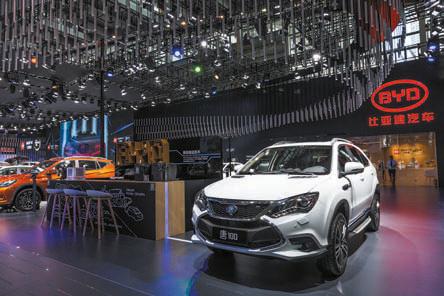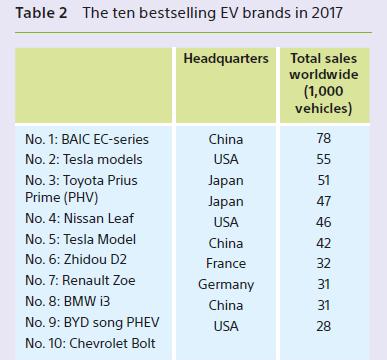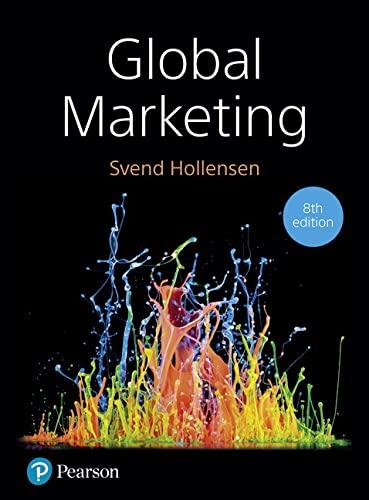High levels of air pollution and carbon emissions, as well as a perceived energy shortage, are all
Question:
High levels of air pollution and carbon emissions, as well as a perceived energy shortage, are all cited as reasons why electric vehicles will surely become a major factor in the global auto industry going forward.
The flip side of that coin is that high costs, short driving ranges, long charging times, lack of charging facilities, and battery maintenance issues are major obstacles faced by all electric vehicle manufacturers.
So far, the negatives of electric vehicles appear to outweigh the positives in the minds of individual consumers. Despite the media hype, electric cars have not yet grabbed a meaningful share in any of the three major auto markets – North America, Western Europe or China – which collectively account for

Moreover, declining oil prices and the increase in energy supply caused by the development of shale gas reserves threaten to halt any momentum that may have been achieved in recent years when oil was trading above $100 per barrel. At the current price of $70 per barrel (end of Summer 2018), the economics of electric vehicles to the consumer have become a bit less attractive.
Despite these facts, the global number of electric vehicles has exploded since 2011. But the 320,000 electric cars bought worldwide in 2014 should be seen in comparison with the roughly 68 million new passenger cars that were bought worldwide in 2014. Three years later (2017) the total number of new passenger cars has increased to 74 million, but the sales of electric cars has increased to 1,200,000.
There are two types of electric cars (EV = Electric Vehicles):
• BEV (Battery Electric Vehicle): has to be plugged in to an electric power source to charge. Dependent on the vehicle, they have varying charging times and driving ranges.
• PHEV (Plug-in Hybrid Electric Vehicle): a hybrid electric vehicle that is a combination of a normal fuel-driven engine with a battery that can be recharged by plugging it into an external source of electric power.
In 2017, 1.2 million electric cars were sold around the world, a new record. The number of Teslas, Nissan Leafs, BYDs and other EVs in circulation worldwide has now surpassed 3 million, an increase of 50 per cent from 2016. In 2017 there were approximately 760,000 electric cars driving on American roads, along with a further 820,000 in Europe. Chinese drivers have become hugely enthusiastic about the technology in recent years and in 2017, China could boast the largest fleet of EVs in any country, 1.23 million.
Table 1 also provides an overview of the number of battery electric vehicles (BEV) and plug-in hybrid vehicles (PHEV) sold in selected countries last year.
China had the highest sales figures of any nation by far with 579,000 EVs sold. The vehicles are starting to make inroads into China’s highly competitive market and they had a 2.2 per cent share of total car sales in 2017 – that’s more than in the US where the market share for EVs stood at 1.2 per cent.
In terms of sales, American customers bought 198,000 EVs in 2017, while France sold 118,000. Norway has become renowned for its love affair with electric vehicles and is still posting healthy sales figures.
Last year, 62,000 EVs were sold in Norway and they had an impressive slice of the total car sales at 39 per cent. In emerging economies, where road quality and electrical infrastructure still need further refinement, the technology is still waiting to take off. In 2017, 2,000 EVs were sold in India while in Brazil, total sales figures only amounted to 360 EVs.
Of the total sales of EVs in 2017, the BEV type accounted for approximately 68 per cent of the total sales. The BEV share is higher in China. The reason is partly in the segment composition of Chinese plug-in sales. Half of these sales are in the Mini and Small segments, where PHEVs make less sense (PHEV is a better principle for bigger cars).
The key drivers of EV sales are:
• Government subsidies: Any change of the government subsidies in buying an EV can influence the market size immediately • Cost of batteries: The costs of lithium ion batteries decreased by 50 per cent in 2015–17.
Table 2 shows the ten worldwide bestselling EVs in 2017.
In the US, the most-sold EVs are Tesla, Nissan Leaf and Chevrolet Bolt. In Europe the most popular EVs are Renault ZOE, Nissan Leaf, BMW i3, Tesla Model S and VW e-Golf. In China, the bestselling brands in 2017 all came from China, e.g. BAIC, SAIC and BYD.
For example the Zhidou D2 is a small EV, retailing for under USD7000 (after subsidies).


BYD (China)
BYD Auto Co., Ltd is a Chinese privately owned automobile manufacturer and a wholly owned subsidiary of BYD Company. It was founded in January 2003, following BYD Company’s acquisition of Tsinchuan Automobile Company in 2003. Its principal activity is the design, development, manufacture and distribution of automobiles, buses, forklifts, rechargeable batteries and trucks sold under the BYD brand.
In 2008, BYD Auto began selling its first mass-produced PHEV. It also has a 50:50 joint venture with Daimler AG, Shenzhen BYD Daimler New Technology Co., Ltd, which develops and manufactures luxury electric cars sold under the Denza brand.
BYD claims that the company name stands for ‘Build Your Dream’. The manufacturer is also one of the key manufacturers of battery cells and has been the most aggressive among all Chinese EV makers in its push into cars that charge from the grid electricity.
BYD was China’s top EV manufacturer in 2016 with 100,000 units delivered, out of a total sales of 494,000 cars. The split between EVs and PHEVs was 50:50. In 2017 the Chinese competitor BAIC took over the leadership in selling EVs to the Chinese market.
While BYD’s EV sales are nearly only domestic, some of their other car models are exported to other developing countries. BYD cars are sold in Bahrain by Fakhro Motors, distributed in the Dominican Republic by Peravia Motors (3,000 cars serve as taxis in the capital, Santo Domingo). BYD cars are also offered in Ukraine and Moldova.
The company has also expressed a desire to enter the European, Iranian and Israeli markets. BYD opened its Iranian branch under the name Karmania in 2016. BYD also opened its North American headquarters in Los Angeles in 2011, and planned to start selling EVs there in 2012, but this was delayed. BYD planned to hit the American streets by the end of 2018 with the BYD E6 model.
In a move seen as a precursor to a US introduction, BYD hired the famous actor Leonardo DiCaprio as its global brand ambassador. He commands an enormous following in China where he is known as Little Li. His Twitter China account shows followers in millions.
Questions
1. What are BYD’s competitive advantages in the electric car business?
2. List the criteria that you should use for choosing new international markets for BYD electrical cars.
3. If you were to advise BYD would you recommend them to use the ‘organic’ or ‘born global’ pathway for the internationalization of its EVs?
4. Will the use of Leonardo DiCaprio help with penetration of the US EV market?
Step by Step Answer:






